1
Consider this image of a Buddhist sculpture. Based on its characteristics, in what area during the Kushan Dynasty was this sculpture made?
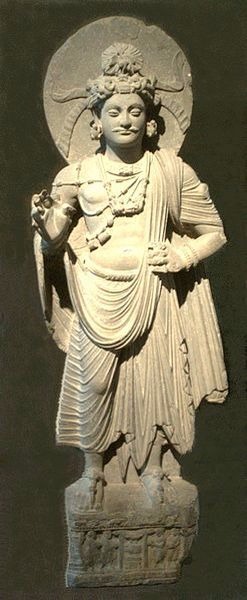
Choose one answer.
|
a. Mathura |
||
|
b. Gandhara |
||
|
c. Sarnath |
||
|
d. Kondavane |
||
|
e. None of the Above |
Question 2
Consider this image of a Buddhist sculpture. This image depicts what kind of Buddhist figure?

Choose one answer.
|
a. Bodhisattva |
||
|
b. Aspara |
||
|
c. Buddha |
||
|
d. Demon king |
||
|
e. Arhat |
Question 3
This image depicts what kind of Buddhist architecture?
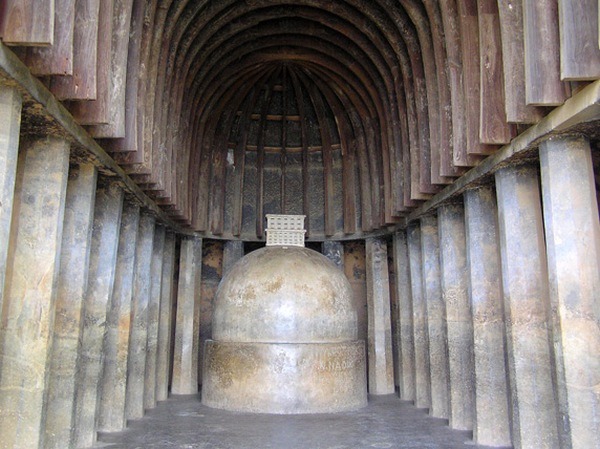
Choose one answer.
|
a. Chaitya Hall |
||
|
b. Pagoda |
||
|
c. Image Hall |
||
|
d. Vihara |
||
|
e. Stupa |
Question 4
This image depicts which Buddhist pilgrimage site?
.
.
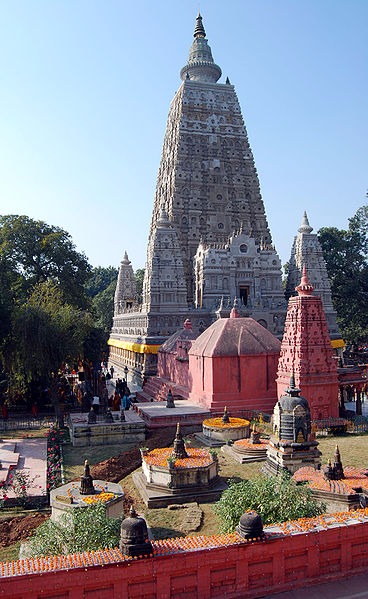
Choose one answer.
|
a. Sanchi |
||
|
b. Gyantse Stupa |
||
|
c. Bodhgaya |
||
|
d. Angkor Thom |
||
|
e. Tōdai-ji |
Question 5
This image depicts which Buddhist pilgrimage site?
.
.
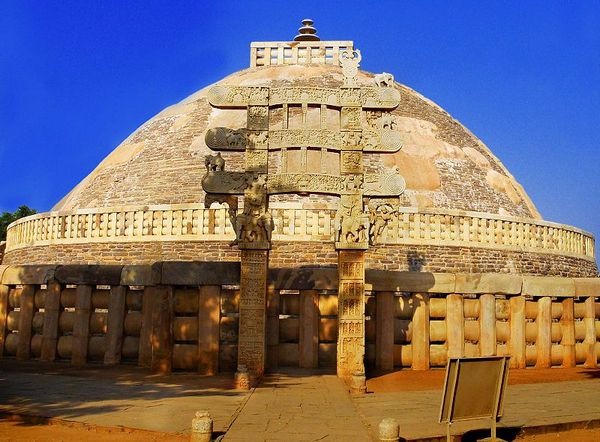
Choose one answer.
|
a. Bodhgaya |
||
|
b. Gyantse |
||
|
c. Sanchi |
||
|
d. Angkor Thom |
||
|
e. Pagan |
Question 6
This painted mural is from what cave site?
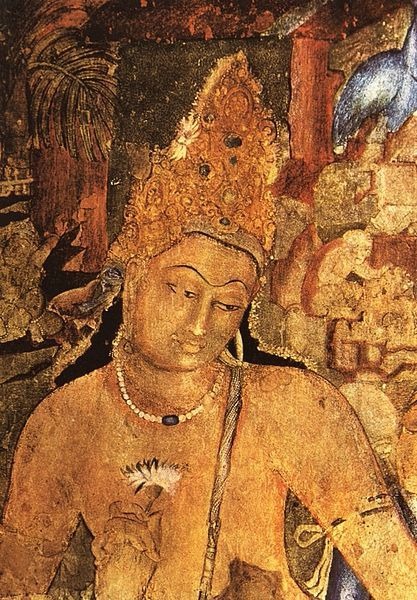
Choose one answer.
|
a. Yungang |
||
|
b. Ajanta |
||
|
c. Longmen |
||
|
d. Ellora |
||
|
e. None of the above |
Question 7
This sculpture was created during which period?
.
.
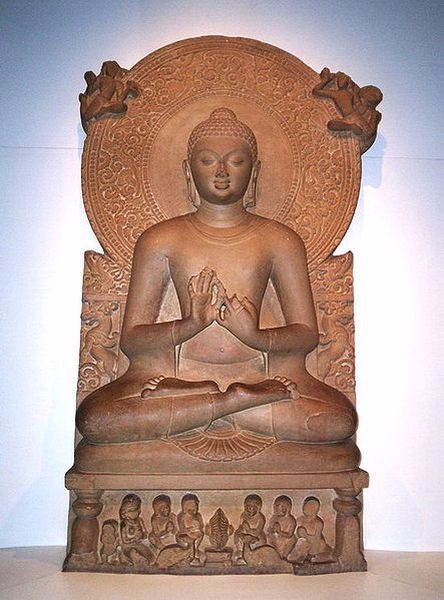
Choose one answer.
|
a. Mauryan |
||
|
b. Shunga |
||
|
c. Kushan |
||
|
d. Gupta |
||
|
e. None of the above |
Question 8
Under what empire did the “ideal form” of the Buddha, which would be the model for future generations throughout Southeast and East Asia, appear?
Choose one answer.
|
a. Pala Empire |
||
|
b. Mauryan Empire |
||
|
c. Kushan Empire |
||
|
d. Gupta Empire |
||
|
e. Chalukya Empire |
Question 9
Under which empire does the first iconic depiction of the Buddha appear?
Choose one answer.
|
a. Gupta |
||
|
b. Mauryan |
||
|
c. Pallava |
||
|
d. Kushan |
||
|
e. Harsha |
Question 10
What are Buddhist symbolic hand gestures called?
Choose one answer.
|
a. Chaityas |
||
|
b. Mudras |
||
|
c. Yogas |
||
|
d. Lakshanas |
||
|
e. None of the above |
Question 11
What are chaityas?
Choose one answer.
|
a. Hemispherical mounds that house the relics of the Buddha |
||
|
b. Halls of worship made out of brick or excavated from rock |
||
|
c. Tower-like structures that house the relics of the Buddha or his followers |
||
|
d. Large stone pillars commissioned by Emperor Ashoka |
||
|
e. None of the above |
Question 12
What are jataka tales?
Choose one answer.
|
a. Stories about the lives of the Buddha’s disciples |
||
|
b. Stories about the lives of bodhisattvas |
||
|
c. Stories about the previous lives of the Buddha |
||
|
d. All of the above |
||
|
e. A and B only |
Question 13
Which of the following Indian emperors created and inscribed laws inspired by Buddhist teachings on rocks and pillars, some of them topped with sculptures of animals?
Choose one answer.
|
a. Kanishka |
||
|
b. Chandragupta I |
||
|
c. Ashoka |
||
|
d. Shah Jahan |
||
|
e. None of the above |
Question 14
Which of the following is a pilgrimage site associated with events during the Buddha’s life?
Choose one answer.
|
a. Bodhgaya |
||
|
b. Lumbini |
||
|
c. Sankasya |
||
|
d. Sarnath |
||
|
e. All of the above |
Question 15
Which of the following is a way in which the Buddha was depicted in early Buddhist art?
Choose one answer.
|
a. As a sign |
||
|
b. As a pair of foot prints |
||
|
c. As an empty seat |
||
|
d. In a jataka tale |
||
|
e. All of the above |
Question 16
Which of the following is NOT depicted on the gates of the Great Stupa at Sanchi?
Choose one answer.
|
a. Jataka tales |
||
|
b. Iconic representations of the Buddha |
||
|
c. Fertility figures |
||
|
d. All of the above |
||
|
e. None of the above |
Question 17
Which of the following is NOT one of the core beliefs of both Theravada and Mahayana Buddhism?
Choose one answer.
|
a. The Eightfold Path |
||
|
b. Nirvana |
||
|
c. The Four Noble Truths |
||
|
d. Bodhisattvas |
||
|
e. Karma and reincarnation |
Question 18
Which of the following is NOT usually a distinguishing iconographic feature of the Buddha?
Choose one answer.
|
a. Earrings and bodily adornments |
||
|
b. A bulge on the top of his head |
||
|
c. Elongated earlobes |
||
|
d. A whirl of hair between his eyebrows |
||
|
e. Webbed hands and feet |
Question 19
Which of the following is the name of a site which is famous for its Buddhist rock-cut caves and murals?
Choose one answer.
|
a. Khajuraho |
||
|
b. Bhimbetka |
||
|
c. Elephanta |
||
|
d. Ajanta |
||
|
e. Mahabalipuram |
Question 20
Which of the following is the site of a famous Buddhist monastic university?
Choose one answer.
|
a. Nalanda |
||
|
b. Ellora |
||
|
c. Sanchi |
||
|
d. Sarnath |
||
|
e. Karle |
Question 21
Which of the following is true about the rock-cut caves at Ellora?
Choose one answer.
|
a. They were only made by Buddhist worshippers. |
||
|
b. None of the caves contain small stupas. |
||
|
c. They are situated along an ancient trade route. |
||
|
d. All of the above |
||
|
e. A and B only |
Question 22
Which of the following is true of Buddhist stupas?
Choose one answer.
|
a. Small stupas were often incorporated into chaitya halls and monasteries. |
||
|
b. They are meant to be circumambulated. |
||
|
c. In East Asia, the hemispherical form of the stupa evolved into the pagoda. |
||
|
d. They house the relics of the Buddha. |
||
|
e. All of the Above |
Question 23
Which of the following statements is NOT characteristic of Mathuran Buddhist sculpture during the Kushan Dynasty?
Choose one answer.
|
a. Mathuran Buddhist sculptures appear as organic, fleshy human forms. |
||
|
b. Mathuran Buddhist sculptures are made of sandstone. |
||
|
c. Mathuran Buddhist sculptures were influenced by Greco-Roman sculpture. |
||
|
d. Mathuran Buddhist sculptures are often depicted semi-nude. |
||
|
e. All of the above |
Question 24
Why is Bodh Gaya such an important Buddhist pilgrimage site?
Choose one answer.
|
a. It was where the Buddha was born. |
||
|
b. It is where the Buddha died. |
||
|
c. It is where the Buddha gave his first sermon. |
||
|
d. It is where the Buddha sat under the Bodhi tree until he obtained enlightenment. |
||
|
e. All of the above |
Question 25
Which of the following Buddhist pilgrimages sites is famous for its stupas?
Choose one answer.
|
a. Sanchi |
||
|
b. Barhut |
||
|
c. Amaravati |
||
|
d. All of the above |
||
|
e. None of the above |
Question 26
Based on their floor plan, what are the two basic types of Pagan temples?
Choose one answer.
|
a. One type has an open sanctuary; the other has two open sanctuaries. |
||
|
b. One type has a solid core that is ringed by a corridor; the other type has parallel side chambers with barrel vaults. |
||
|
c. One type has a central chamber with a courtyard to its rear; the other has two open sanctuaries. |
||
|
d. One type has an open central sanctuary; the other has a solid core that is ringed by a corridor. |
||
|
e. None of the above |
Question 27
The Ayutthayan rulers mainly followed which Buddhist school(s)?
Choose one answer.
|
a. Vajrayana |
||
|
b. Mahayana |
||
|
c. Theravada |
||
|
d. All of the above |
||
|
e. None of the above |
Question 28
The Pagan rulers mainly followed which Buddhist school(s)?
Choose one answer.
|
a. Vajrayana |
||
|
b. Mahayana |
||
|
c. Theravada |
||
|
d. All of the above |
||
|
e. None of the above |
Question 29
This image depicts stupas and temples dotting the landscape that were built under which dynasty?
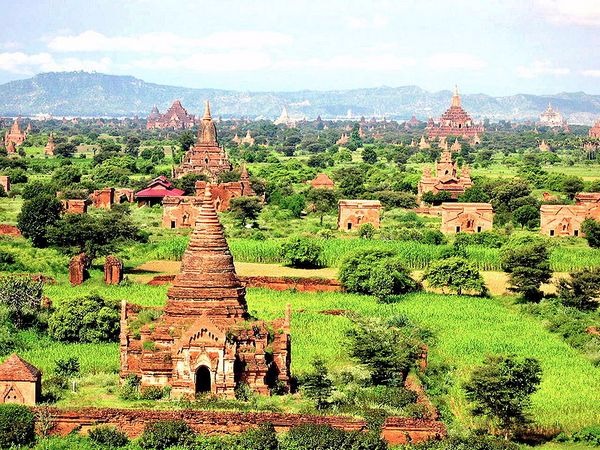
Choose one answer.
|
a. The Guptas |
||
|
b. The Ayutthayas |
||
|
c. The Saliendras |
||
|
d. The Pagans |
||
|
e. The Khmers |
Question 30
This image depicts temple towers left after the destruction of the capital city of which kingdom?
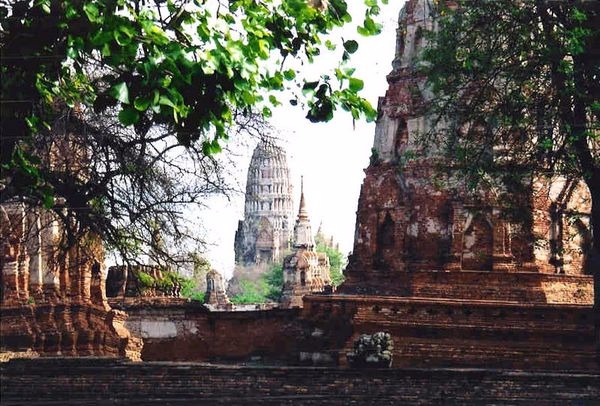
Choose one answer.
|
a. Pala |
||
|
b. Ayutthaya |
||
|
c. Saliendra |
||
|
d. Pagan |
||
|
e. Khmer |
Question 31
This image depicts what temple?
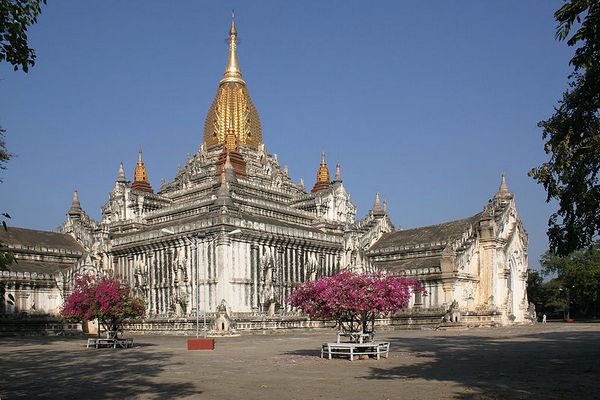
Choose one answer.
|
a. Borobudur |
||
|
b. Ananda |
||
|
c. Bayon |
||
|
d. Nagayon |
||
|
e. Bodhgaya |
Question 32
This image from Borobudur depicts what episode in the Buddha’s life?
.
.
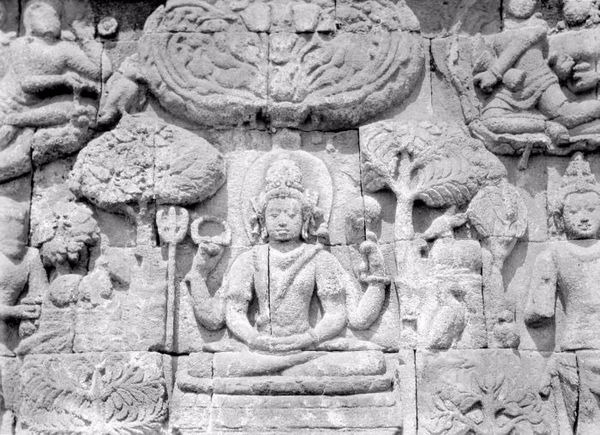
Choose one answer.
|
a. When he meditated underneath the Bodhi tree |
||
|
b. When he died and achieved parinirvana |
||
|
c. When he taught his first sermon |
||
|
d. All of the above |
||
|
e. None of the above |
Question 33
This image from Borobudur is from the topmost level of the structure that represents which part of the Buddhist universe?
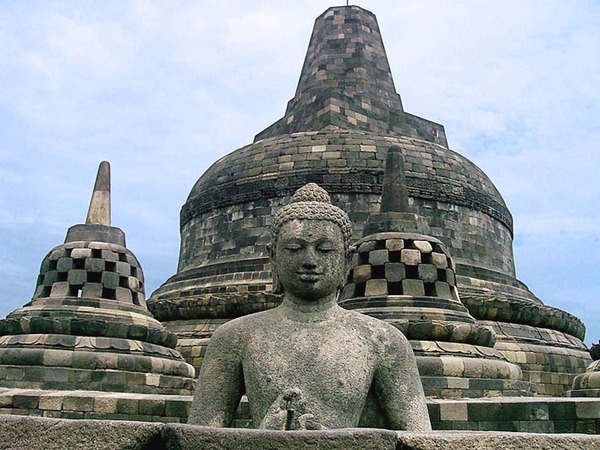
Choose one answer.
|
a. Mount Meru |
||
|
b. The Earthly Realm |
||
|
c. The Realm of Forms |
||
|
d. The Realm of Formlessness |
||
|
e. None of the above |
Question 34
This image is an example of a Buddha created under which rulers?
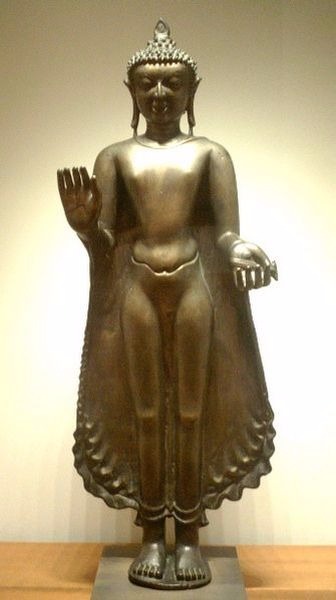
Choose one answer.
|
a. The Pagans |
||
|
b. The Khmers |
||
|
c. The Guptas |
||
|
d. The Ayutthayas |
||
|
e. The Saliendras |
Question 35
This image is of what Buddhist pilgrimage site?
.
.
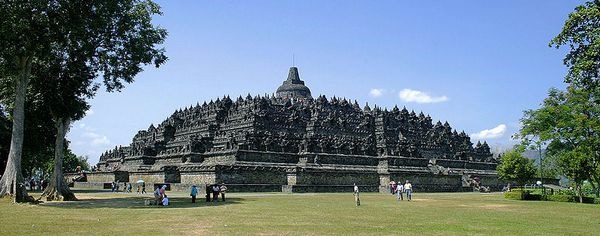
Choose one answer.
|
a. Borobudur |
||
|
b. Sanchi |
||
|
c. Pagan |
||
|
d. Bodhgaya |
||
|
e. Sarnath |
Question 36
What does the word “Wat” designate in such sites as Wat Ratchabana and Wat Mahathat?
Choose one answer.
|
a. The site has a stupa that contains the relics of the Buddha. |
||
|
b. The site is a university. |
||
|
c. The site is an important Buddhist pilgrimage site. |
||
|
d. The site is a monastery-temple. |
||
|
e. The site has served as both a Buddhist and a Hindu place of worship. |
Question 37
What is the name of the Thai building where in 1957 a cache of Buddha images, votive tablets, ritual objects, and royal jewelry were discovered?
Choose one answer.
|
a. Angkgor Wat |
||
|
b. Wat Ratchaburana |
||
|
c. Wat Mahathat |
||
|
d. The Ananda Temple |
||
|
e. None of the above |
Question 38
What was found inside the Phra Mongkhon Bophit, a colossal image of the Buddha?
Choose one answer.
|
a. A dedicatory scroll |
||
|
b. Other smaller statues of the Buddha |
||
|
c. A list of donors |
||
|
d. All of the above |
||
|
e. None of the above |
Question 39
When was the Buddhist site of Borobudur constructed?
Choose one answer.
|
a. 1st century BCE |
||
|
b. 18th century |
||
|
c. 8th-9th centuries |
||
|
d. 3rd-4th centuries |
||
|
e. 5th century |
Question 40
Which Buddhist temple famous for its larger than life heads of the Bodhisattva Avalokiteshvara is shown here?
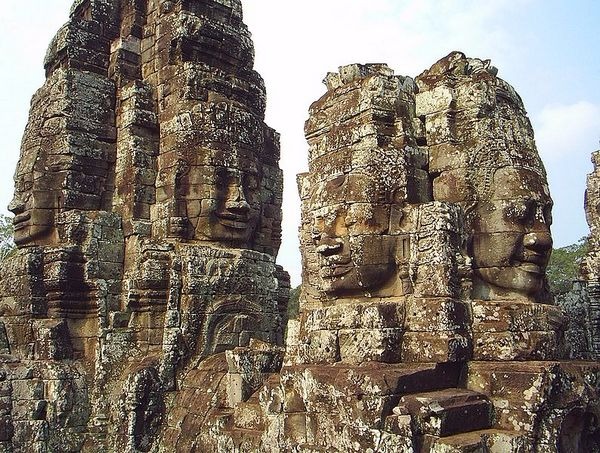
Choose one answer.
|
a. Foguang |
||
|
b. Bayon |
||
|
c. Borobudur |
||
|
d. Myazedei |
||
|
e. Wat Mahathat |
Question 41
Which Khmer king adopted Mahayana Buddhism?
Choose one answer.
|
a. Suryavarman II |
||
|
b. Jayavarman VII |
||
|
c. Indravarman II |
||
|
d. Chandragupta I |
||
|
e. None of the above |
Question 42
Which of the following is false about Borobudur?
Choose one answer.
|
a. It was constructed to serve as a training center. |
||
|
b. It was constructed in the form of a mandala. |
||
|
c. It was constructed during the rule of the Saliendra kings. |
||
|
d. It is associated with Theravada Buddhism. |
||
|
e. All of the above |
Question 43
Which of the following is false about Borobudur?
Choose one answer.
|
a. It is a Mahayana Buddhist site. |
||
|
b. It can be divided into several vertical segments which represent different parts of the Buddhist universe. |
||
|
c. It was constructed as a site of worship. |
||
|
d. Reliefs on its most bottom level were later covered over and only discovered recently. |
||
|
e. All of the above |
Question 44
Which of the following is false in regard to Pagan Buddhist architecture?
Choose one answer.
|
a. Most Pagan structures were made of brick plastered with stucco. |
||
|
b. Many remains of Buddhist Pagan architecture include stupas, temples, monasteries, ordination halls, and libraries. |
||
|
c. Pagan temples and stupas were built adjacent to one another and were often created as part of a single complex. |
||
|
d. Some Pagan stupas have the external form of a stupa but can be entered, and they contain an inner corridor and multiple shrines. |
||
|
e. All of the above |
Question 45
Which of the following is NOT characteristic of early Ayutthayan sculpture?
Choose one answer.
|
a. A rounded face |
||
|
b. Eyes cast forward rather than down |
||
|
c. Wide mouth with what might be a mustache along the upper lip |
||
|
d. A band or double band at the hairline |
||
|
e. A robust body |
Question 46
Which of the following is true about the Bayon?
Choose one answer.
|
a. It was the state temple of Jayavarman VII. |
||
|
b. It was a Mahayana Buddhist temple. |
||
|
c. It represented Mount Meru. |
||
|
d. It was constructed in the center of Angkor Thom. |
||
|
e. All of the above |
Question 47
Which of the following is true of the Ananda Temple?
Choose one answer.
|
a. It is a Mon-style temple. |
||
|
b. Unlike other Pagan temples, it has two stories. |
||
|
c. It is a Mahayana Buddhist temple. |
||
|
d. Its cross-shaped plan centers on four shrines set back-to-back around a solid core. |
||
|
e. All of the above |
Question 48
Which of the following rulers were primarily Hindu but also supported Buddhism?
Choose one answer.
|
a. The Pagans |
||
|
b. The Saliendras |
||
|
c. The Khmers |
||
|
d. The Ayutthayas |
||
|
e. All of the above |
Question 49
Which ruler built the Ananda Temple?
Choose one answer.
|
a. Jayavarman VII |
||
|
b. Kyanzittha |
||
|
c. Alaungsithu |
||
|
d. Narapatisithu |
||
|
e. None of the above |
Question 50
Which of the following is false in regard to Buddhism in Southeast Asia?
Choose one answer.
|
a. All Buddhists in Southeast Asia are Mahayana Buddhists. |
||
|
b. During many periods, Buddhism and Hinduism coexisted in areas of Southeast Asia. |
||
|
c. Buddhism had spread to Southeast Asia by the seventh century CE. |
||
|
d. Indigenous and pantheistic beliefs survived and were integrated alongside Buddhism in Southeast Asia. |
||
|
e. All of the above |
Question 51
During certain periods, Nepalese art and artists were imported to which of the following countries?
Choose one answer.
|
a. India |
||
|
b. China |
||
|
c. Korea |
||
|
d. Burma |
||
|
e. None of the Above |
Question 52
Images in Mahayana Buddhism are commissioned for which of the following reasons?
Choose one answer.
|
a. To accrue merit |
||
|
b. To serve as aids in meditation |
||
|
c. To commemorate the death of an individual |
||
|
d. All of the above |
||
|
e. None of the above |
Question 53
This image depicts what Buddhist site?
license. This photograph was taken by Phillipp Roelli.
license. This photograph was taken by Phillipp Roelli.
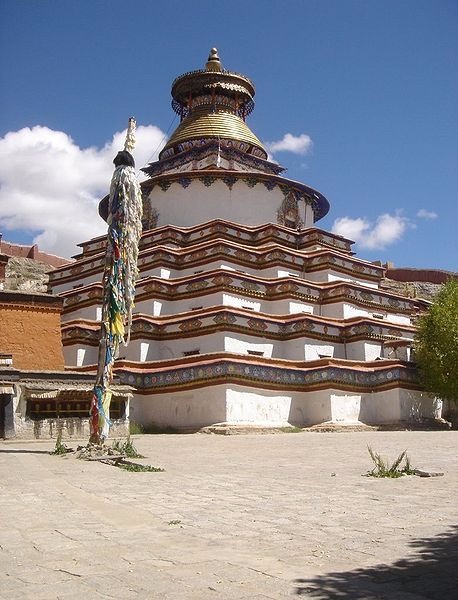
Choose one answer.
|
a. The Kumbun Stupa at Gyantse |
||
|
b. Samye Monastery |
||
|
c. Bodhgaya |
||
|
d. Ananda Temple |
||
|
e. None of the above |
Question 54
This image depicts which Buddhist site?
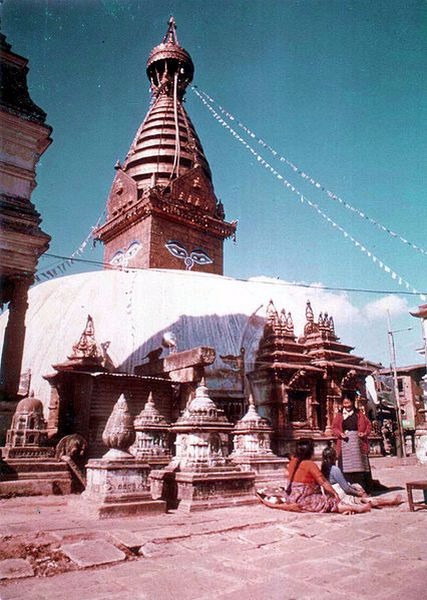
Choose one answer.
|
a. Bodhgaya |
||
|
b. Swayambhunath Stupa |
||
|
c. Bayon |
||
|
d. Gyantse Stupa |
||
|
e. Ananda Temple |
Question 55
This image is an example of what important Buddhist ritual object?
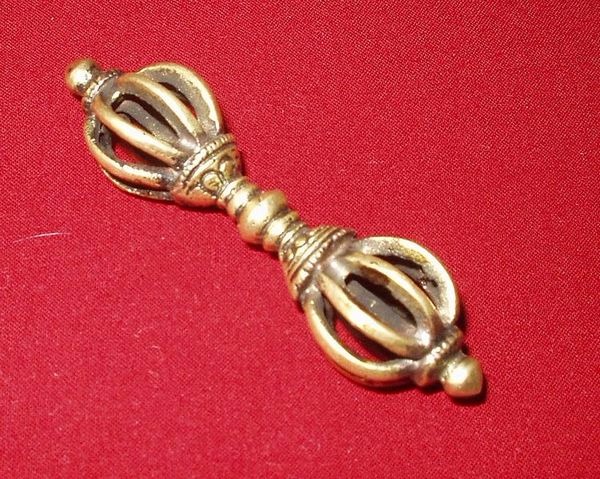
Choose one answer.
|
a. A thangka |
||
|
b. A lung-ta |
||
|
c. A vajra |
||
|
d. An incense holder |
||
|
e. None of the above |
Question 56
This object, now in the collection of the Rubin Museum of Art, is an example of what kind of Tibetan Buddhist art?
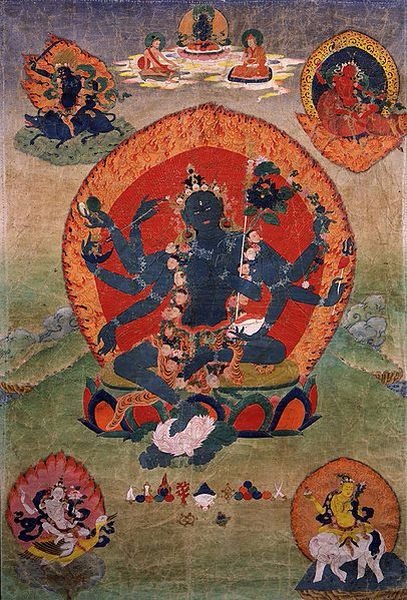
Choose one answer.
|
a. An illuminated manuscript |
||
|
b. A prayer flag |
||
|
c. A thangka |
||
|
d. A vajra |
||
|
e. None of the above |
Question 57
What are paubhas?
Choose one answer.
|
a. Devotional paintings on cloth |
||
|
b. Guardian figures placed outside Newar Buddhist temples |
||
|
c. A special ritual bell that provides protection against demons |
||
|
d. Bronze figurines of the moon god Chandra |
||
|
e. None of the above |
Question 58
What are the most important ritual objects in Tibetan Buddhism?
Choose one answer.
|
a. The torma and prayer wheel |
||
|
b. The torma and bell |
||
|
c. The vajra and prayer wheel |
||
|
d. The vajra and torma |
||
|
e. The vajra and bell |
Question 59
Which of the following is false about Newar Buddhism?
Choose one answer.
|
a. It is a form of Vajrayana Buddhism. |
||
|
b. It is practiced throughout Nepal. |
||
|
c. Newar Buddhists have lived in a society that is primarily Hindu. |
||
|
d. Paubhas are important Newar Buddhist ritual objects. |
||
|
e. All of the above |
Question 60
Which of the following is false about the Dalai Lama?
Choose one answer.
|
a. His traditional home is located in the Samye Monastery. |
||
|
b. He is the religious and political leader of Tibet. |
||
|
c. His name means “Oceanic Lama.” |
||
|
d. When the old lama dies, he is replaced by a special child born later in the same year who through tests is proven to be the reincarnation of the old lama. |
||
|
e. All of the above |
Question 61
Which of the following is false about Tibetan Art?
Choose one answer.
|
a. Every aspect, such as color, shape, and placement, has symbolic significance in Tibetan Art. |
||
|
b. Tibetans only consider certain objects, such as ornately decorated bronze statues as works of art. |
||
|
c. Tibetan Buddhist art is always directly commissioned from an artist. |
||
|
d. Tibetan artists usually do not sign their art works. |
||
|
e. All of the above |
Question 62
Which of the following is false in regard to Nepalese sculpture?
Choose one answer.
|
a. Nepalese metal sculptures are either heavily gilded or, if the gold has worn off, have a slightly reddish patina that derives from their high copper content. |
||
|
b. Nepalese sculptures are stylistically nearly identical to Indian Guptan and Palan sculpture. |
||
|
c. Later Nepalese sculpture is often decorated with inlaid semi-precious stones. |
||
|
d. Nepalese wooden sculptures usually served as struts to support roofs, door surrounds, or as decorations. |
||
|
e. All of the above |
Question 63
Which of the following is false in regard to the Boudhanath Stupa?
Choose one answer.
|
a. It looks like a giant mandala from above. |
||
|
b. It is the center of Buddhist culture in Kathmandu. |
||
|
c. It is one of the most important centers of Tibetan Buddhism. |
||
|
d. A pair of Buddhas decorate the square base at the pyramid on top of the stupa. |
||
|
e. All of the above |
Question 64
Which of the following is false in regard to the Potala Palace?
Choose one answer.
|
a. It is the traditional winter residence of the Dalai Lama. |
||
|
b. It is named after the paradise of the Buddha Shakyamnui. |
||
|
c. The red buildings at the center are the Potrang Marpo, or the red palace, where religious services took place. |
||
|
d. It was first built in the seventh century. |
||
|
e. All of the above |
Question 65
Which of the following is false in regard to the Swayambhunath Stupa?
Choose one answer.
|
a. It is known as the “Self-Creating Stupa.” |
||
|
b. It is famous for the many peacocks that call it home. |
||
|
c. It is known for the sleepy Buddhist eyes that decorate the topmost portion of the stupa. |
||
|
d. The earliest written record of the stupa dates to the fifth century. |
||
|
e. All of the above |
Question 66
Which of the following is false in regard to Tibetan Buddhism?
Choose one answer.
|
a. Its leader is the Dalai Lama. |
||
|
b. It is a form of Theravada Buddhism. |
||
|
c. It also contains elements of the Bön religion. |
||
|
d. The Great Stupa at Gyantse is one of its important pilgrimage sites. |
||
|
e. All of the above |
Question 67
Which of the following is true about Nepalese painting?
Choose one answer.
|
a. Newar artists made mostly illuminated manuscripts, book covers, and devotional paintings on cloth. |
||
|
b. Nepalese paintings are conservative in technique, style, and iconography, but subtle changes occurred in composition, palette, style, and motifs over time. |
||
|
c. The decoration of illuminated manuscript covers usually do not relate to the text inside. |
||
|
d. All of the above |
||
|
e. None of the above |
Question 68
Which of the following is true about Nepalese sculpture?
Choose one answer.
|
a. It does not have discernable Buddhist or Hindu styles. |
||
|
b. Nepalese sculptors worked with stone, wood, metal, and terracotta. |
||
|
c. Stylistically, Nepalese sculpture grew out of the art of Gupta India, and later was influenced by that of Pala India. |
||
|
d. All of the above |
||
|
e. None of the above |
Question 69
Which of the following is true about Thangka paintings?
Choose one answer.
|
a. They follow strict roles of iconography. |
||
|
b. They must be consecrated in a ceremony by an ordained lama. |
||
|
c. They must be framed in silk brocade. |
||
|
d. All of the above |
||
|
e. None of the above |
Question 70
Which of the following is true about the Great Kumbum Stupa at Gyantse?
Choose one answer.
|
a. It is the largest stupa in Burma. |
||
|
b. It is a three-dimensional mandala. |
||
|
c. Inside the stupa there are six floors that contain chapels filled with murals and sacred statues. |
||
|
d. All of the above |
||
|
e. None of the above |
Question 71
Which of the following is true about Tibetan Art?
Choose one answer.
|
a. Many artworks serve as guides in meditation. |
||
|
b. Ritual objects are handled by monks or lay persons as part of rituals or worship. |
||
|
c. Many objects are part of an altar, where worshippers make offerings of food, scarves, tea, money, or other valuables. |
||
|
d. All of the above |
||
|
e. None of the above |
Question 72
Which of the following is true about Vajrayana Buddhism?
Choose one answer.
|
a. It is a type of Mahayana Buddhism. |
||
|
b. It is based on the esoteric doctrines of the Buddha given to selected disciples. |
||
|
c. It uses meditation, mantras, and rituals to bring about psychological and physiological transformations. |
||
|
d. All of the above |
||
|
e. None of the above |
Question 73
Which of the following is true of Tibetan prayer flags?
Choose one answer.
|
a. Their name means “Wind horse.” |
||
|
b. They often have an image of a horse carrying a load of flaming jewels. |
||
|
c. They are meant to multiply the number of prayers going out. |
||
|
d. They are made by printing carved wood blocks onto pieces of colored or white fabric. |
||
|
e. All of the above |
Question 74
What complex does this image show?
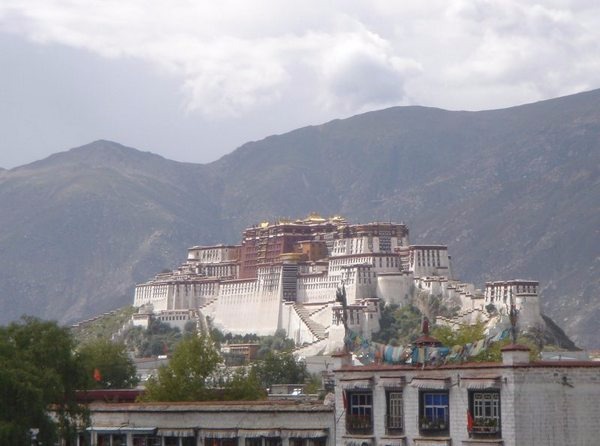
Choose one answer.
|
a. Boudhanath Stupa |
||
|
b. Ananda Palace |
||
|
c. Gyantse Palace |
||
|
d. Foguang Temple |
||
|
e. Potala Palace |
Question 75
Buddhism was the official religion of which of the following Korean kingdoms?
Choose one answer.
|
a. Silla |
||
|
b. Paekche |
||
|
c. Koguryô |
||
|
d. All of the above |
||
|
e. None of the above |
Question 76
During the Koryô Dynasty, Buddhist sects were divided into which two overarching schools?
Choose one answer.
|
a. Theravada and Mahayana |
||
|
b. Kyo and Sŏn |
||
|
c. Pure Land and Zen |
||
|
d. Hwaôm and Kyo |
||
|
e. None of the above |
Question 77
Part of which Buddhist temple is depicted in this image?
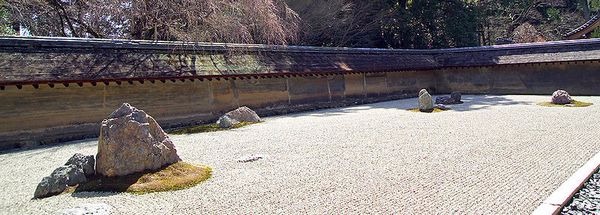
Choose one answer.
|
a. Ryōan-ji |
||
|
b. Borobudur |
||
|
c. Hōryūj-i |
||
|
d. Tōdai-ji |
||
|
e. Pagan |
Question 78
This image depicts a Buddha, bodhisattva, and disciple from which Buddhist cave site?
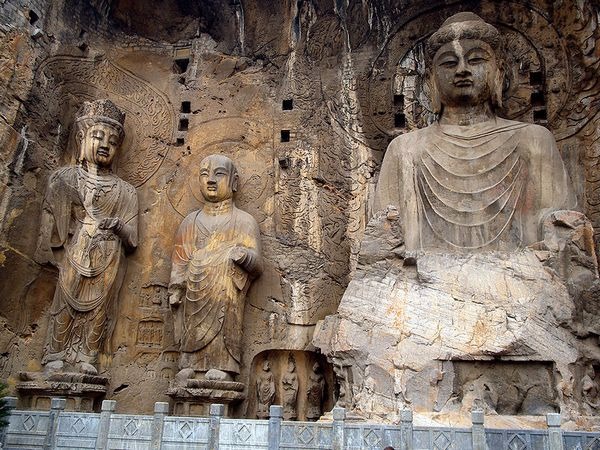
Choose one answer.
|
a. Dunhunag |
||
|
b. Ellora |
||
|
c. Longmen |
||
|
d. Ajanta |
||
|
e. Yungang |
Question 79
This image depicts two Buddhas from what Buddhist cave site?
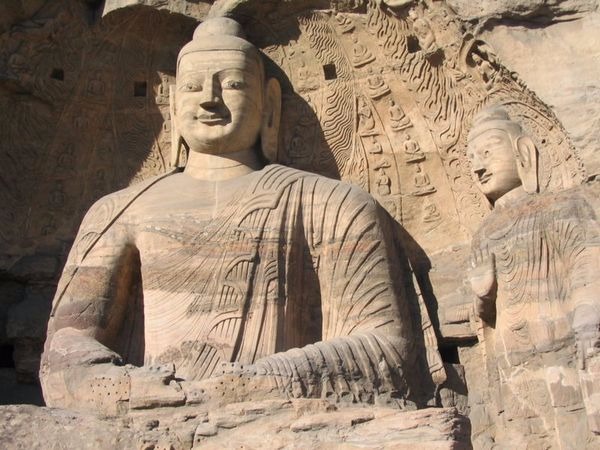
Choose one answer.
|
a. Dunhunag |
||
|
b. Ellora |
||
|
c. Longmen |
||
|
d. Ajanta |
||
|
e. Yungang |
Question 80
This image depicts what structure built in the Tang capital of Chang’an?
license. This image is attributed to Alex Kwok.
license. This image is attributed to Alex Kwok.
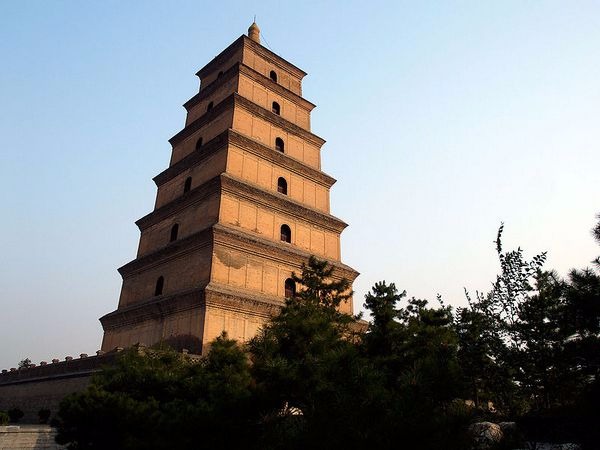
Choose one answer.
|
a. Famen Temple |
||
|
b. Foguang Temple |
||
|
c. Great Goose Pagoda |
||
|
d. Songyue Pagoda |
||
|
e. None of the above |
Question 81
This image depicts what temple?
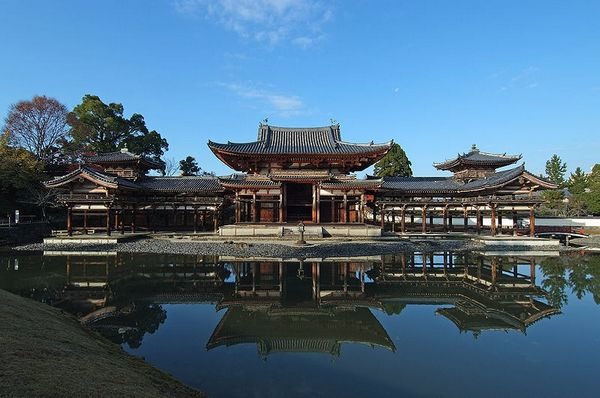
Choose one answer.
|
a. Bayon |
||
|
b. Byōdō-in |
||
|
c. Hōryūj-i |
||
|
d. Tōdai-ji |
||
|
e. Borobudur |
Question 82
This Korean Buddhist statue was made during what time period?
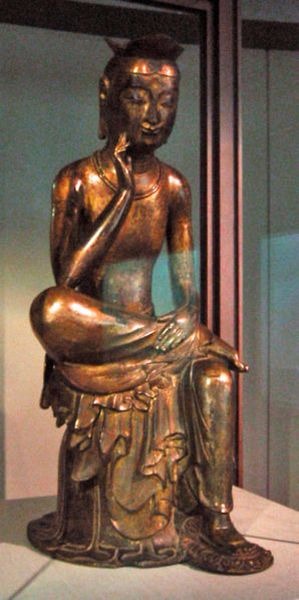
Choose one answer.
|
a. Three Kingdoms Period |
||
|
b. Unified Silla |
||
|
c. Koryŏ Dynasty |
||
|
d. Chosŏn Dynasty |
||
|
e. None of the above |
Question 83
This mural from the Mogao Caves in Dunhuang was created during which dynasty?
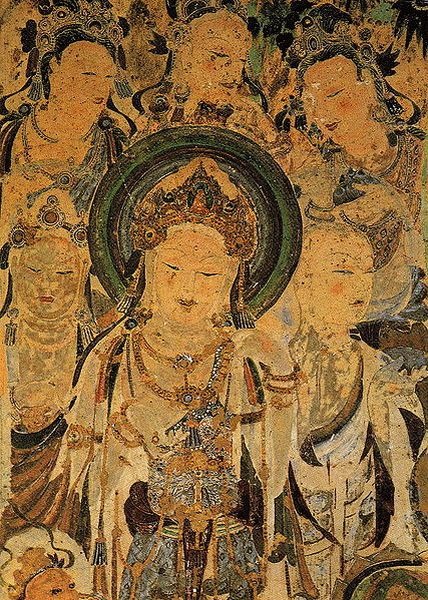
Choose one answer.
|
a. Northern Wei |
||
|
b. Northern Qi |
||
|
c. Sui |
||
|
d. Tang |
||
|
e. Liao |
Question 84
This silver reliquary casket was discovered in 1981 along with many other Buddhist ritual objects in a crypt below the pagoda located at which Chinese temple complex?
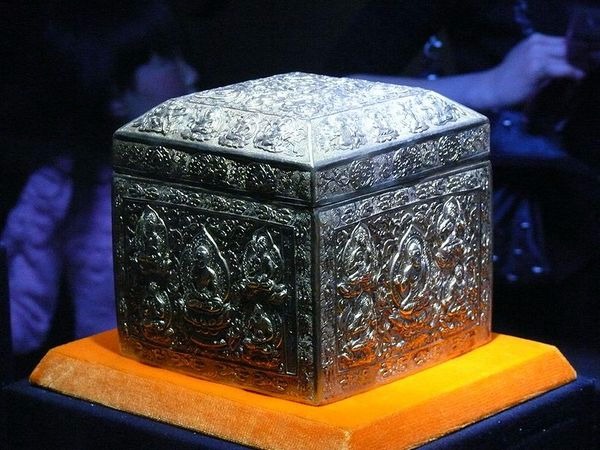
Choose one answer.
|
a. Foguang |
||
|
b. Fengxian |
||
|
c. Famen temple complex |
||
|
d. Dunhuang |
||
|
e. Yungang |
Question 85
What are raigo paintings?
Choose one answer.
|
a. Handscrolls that depicted the world of the Heian court |
||
|
b. Hanging scrolls hung while a person was dying to help them enter the Western Paradise |
||
|
c. A type of handscroll that depicted battles and historical events that became popular after the rise of the warrior class |
||
|
d. Hanging scrolls or handscrolls that depicted events relating to the founding of a temple |
||
|
e. None of the above |
Question 86
What art form is most closely identified with Zen Buddhism?
Choose one answer.
|
a. Ink monochrome painting |
||
|
b. Blue and green landscapes |
||
|
c. Bird and flower paintings |
||
|
d. Gold leaf folding screens |
||
|
e. All of the above |
Question 87
What Buddha is depicted at the center of both of the two most important mandalas of Japanese Esoteric Buddhism?
Choose one answer.
|
a. Amida |
||
|
b. Dainichi Nyorai |
||
|
c. Yakushi |
||
|
d. Shaka |
||
|
e. None of the above |
Question 88
What is the name of the Buddhist cave site where Empress Wu commissioned over 300 images?
Choose one answer.
|
a. Dunhuang |
||
|
b. Yungang |
||
|
c. Longmen |
||
|
d. Juyan |
||
|
e. Chang’an |
Question 89
What is the name of the Silk Road site where Buddhist caves with fabulous murals were constructed?
Choose one answer.
|
a. Chang’an |
||
|
b. Dunhuang |
||
|
c. Juyuan |
||
|
d. Yungang |
||
|
e. Longmen |
Question 90
What was the Phoenix Hall of the Byōdō-in built to represent?
Choose one answer.
|
a. The Eastern Paradise of Yakushi Nyorai |
||
|
b. Mount Sumeru |
||
|
c. The immortal island of Horai |
||
|
d. The Western Paradise of Amida |
||
|
e. None of the above |
Question 91
Which of the following is false in regard to the objects discovered in the crypt of the pagoda at the Famen temple complex?
Choose one answer.
|
a. They included a relic that is supposed to date to the time of Emperor Ashoka. |
||
|
b. The objects all date to the Northern Wei dynasty. |
||
|
c. They included many “decoy” relics, Buddhist statues, and other Buddhist ritual objects. |
||
|
d. They include implements used to store and prepare tea. |
||
|
e. All of the above |
Question 92
Which of the following is false in regard to the Tripitaka Koreana?
Choose one answer.
|
a. It is set of woodblocks for printing the entire Buddhist cannon. |
||
|
b. It was commissioned to protect against foreign invasions. |
||
|
c. It is the second complete set of woodblocks for printing the entire Buddhist cannon made in Korea. |
||
|
d. It is kept in Sŏkkuram. |
||
|
e. All of the above |
Question 93
Which of the following is false in regard to the Taima Mandala?
Choose one answer.
|
a. It depicts Amida Buddha in a landscape of rolling hills. |
||
|
b. It represents the myriad Buddhas as geometric relationships. |
||
|
c. This type of mandala was only made during the Kamakura Period. |
||
|
d. It is used by practitioners of Zen Buddhism. |
||
|
e. All of the above |
Question 94
Which of the following is NOT characteristic of Zen painting?
Choose one answer.
|
a. It is often of Zen patriarchs and teachers. |
||
|
b. Personal expression is always more important than a particular painting style. |
||
|
c. It draws upon secular Chinese themes infused with scholarly symbolism. |
||
|
d. It sometimes includes landscapes and literary figures. |
||
|
e. All of the above |
Question 95
Which of the following is true about the garden at Ryōan-ji?
Choose one answer.
|
a. It is an example of a dry rock garden. |
||
|
b. It is associated with Zen Buddhism. |
||
|
c. It is attributed to Soami. |
||
|
d. It probably originally used the concept of shakkei or “borrowed scenery” in its design. |
||
|
e. All of the above |
Question 96
Which of the following is true of Buddhist paintings made during the Koryŏ Dynasty?
Choose one answer.
|
a. They were usually painted on silk. |
||
|
b. They were painted on both sides of the cloth. |
||
|
c. When finished, an “eye-dotting ceremony” was performed to give life to the images. |
||
|
d. All of the above |
||
|
e. None of the above |
Question 97
Which of the following statement is false about the Foguang temple complex?
Choose one answer.
|
a. All of its buildings date to the Tang Dynasty. |
||
|
b. Its famous east hall is seven bays wide and four bays deep. |
||
|
c. Over 250 statues of arhats line the walls around the alter in its East Hall. |
||
|
d. Its wooden pagoda does not date to the Tang Dynasty. |
||
|
e. All of the above |
Question 98
Which of the following words describe the Zen aesthetic of rusticity, melancholy, loneliness, naturalness, and age?
Choose one answer.
|
a. Chaonoyu |
||
|
b. Raku |
||
|
c. Wabi and sabi |
||
|
d. Sumi-e |
||
|
e. None of the above |
Question 99
Why is the Daibutsu statue of Tōdai-ji so famous?
Choose one answer.
|
a. It is the oldest surviving Buddhist statue in Japan. |
||
|
b. It was made by the sculptor Tori Busshi. |
||
|
c. It is the largest bronze statue in the world. |
||
|
d. All of the above |
||
|
e. None of the above |
Question 100
The rulers of what dynasty initiated the building of Buddhist caves at Yungang?
Choose one answer.
|
a. Northern Wei |
||
|
b. Sui |
||
|
c. Northern Liang |
||
|
d. Tang |
||
|
e. None of the above |